
The Tigray Region, officially the Tigray National Regional State, is the northernmost regional state in Ethiopia. The Tigrai Region is the homeland of the Tigrayan (Tegaru), Irob people and Kunama people. Its capital and largest city is Mekelle. Tigray is the fifth-largest by area, the fourth-most populous, and the fifth-most densely populated of the 11 regional states.

Adwa is a town and separate woreda in Tigray Region, Ethiopia. It is best known as the community closest to the site of the 1896 Battle of Adwa, in which Ethiopian soldiers defeated Italian troops, thus being one of the few African nations to thwart European colonialism. Located in the Central Zone of the Tigray Region, Adwa has a longitude and latitude of 14°10′N38°54′E, and an elevation of 1907 meters. Adwa is surrounded by Adwa woreda.

Yohannes IV was Emperor of Ethiopia from 1871 to his death in 1889 at the Battle of Gallabat, and king of Tigray from 1869 to 1871. During his reign he successfully defended Ethiopia against a large scale Egyptian invasion.
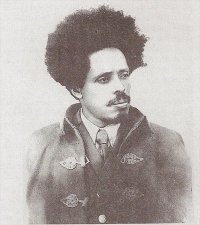
RasAbebe Aregai was an Ethiopian military commander who served as Prime Minister of Ethiopia from 27 November 1957 until his death. He was a victim of the unsuccessful 1960 Ethiopian coup.
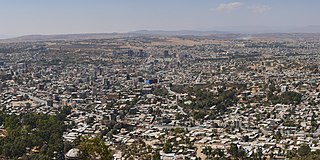
Mekelle, or Mekele, is a special zone and capital of the Tigray Region of Ethiopia. Mekelle was formerly the capital of Enderta awraja in Tigray. It is located around 780 kilometres (480 mi) north of the Ethiopian capital Addis Ababa, with an elevation of 2,254 metres (7,395 ft) above sea level. Administratively, Mekelle is considered a Special Zone, which is divided into seven sub-cities. It is the economic, cultural, and political hub of northern Ethiopia.
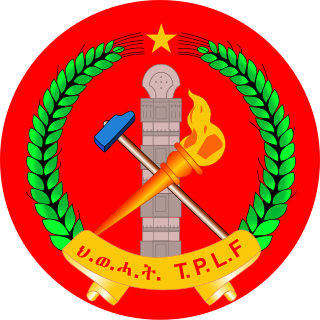
The Tigray People's Liberation Front, also called the Tigrayan People's Liberation Front, is a left-wing ethnic nationalist, paramilitary group, and the former ruling party of Ethiopia. It was classified as a terrorist organization by the Ethiopian government from May 2021 until its removal from the list in March 2023. In older texts and Amharic publications, it is known as Woyane or Wayane.
Wolde Selassie was Ras of the Tigray province between 1788 and 1816, and Regent of the Ethiopian Empire between 1797 and 1800. John J. Halls, in his Life and Correspondence of Henry Salt, preserves a description of this powerful warlord, as "small in stature, and delicately formed, quick in his manner, with a shrewd expression, and considerable dignity in his deportment." Nathaniel Pearce also notes that Ras Wolde was an avid chess player, and "would play at from morning till night".

Tigray Province, also known as Tigre, was a historical province of northern Ethiopia that overlayed the present day Afar and Tigray regions. Akele Guzai borders with the Tigray province. It encompassed most of the territories of Tigrinya-speakers in Ethiopia. Tigray was separated from the northern Tigrinya speaking territories by the Mareb River, now serving as the state border to Eritrea, bordering Amhara region in the south.
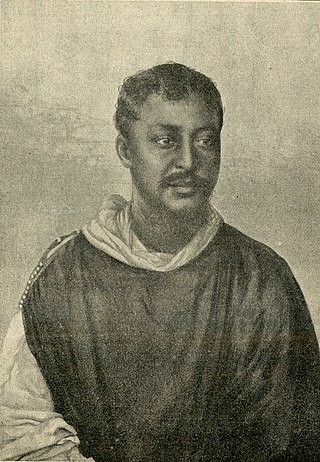
RasMengesha Yohannes was governor of Tigray and a son of Emperor Yohannes IV. His mother was Welette Tekle Haymanot wife of dejazmach Gugsa Mercha. Ras Araya Selassie Yohannes was his younger half brother. Prior to the Battle of Metemma, Mengesha Yohannes was considered to be a nephew of Emperor Yohannes IV. During the battle, the Emperor was mortally wounded and it was on his deathbed that Mengesha Yohannes was acknowledged as his "natural" son and designated as his heir. This created something of a succession problem.
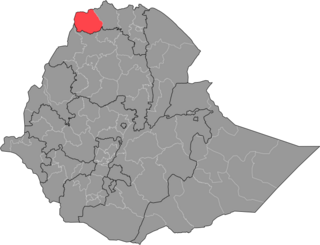
The Western Zone is a zone in the Tigray Region of Ethiopia. It is subdivided into three woredas (districts); from north to south they are Kafta Humera, Welkait and Tsegede. The largest town is Humera. The Western Zone is bordered on the east by the North Western Zone, the south by the Amhara Region, the west by Sudan and on the north by Eritrea. Starting from the late 17th C., internal boundaries are clearly shown, with 37 maps displaying a boundary that is located well south of the Tekeze River, or even south of the Simien mountains. Welkait is explicitly included within a larger Tigray confederation ; it is briefly mapped as part of Amhara in 1891-1894 and part of Gondar from 1944-1990. At other periods it appears independent or part of a larger Mezaga lowland region.

Tigrayans are a Semitic-speaking ethnic group indigenous to the Tigray Region of northern Ethiopia. They speak the Tigrinya language, an Afroasiatic language belonging to the Ethiopian Semitic branch.

Korem is a town and separate woreda in Tigray, Ethiopia. Located on the eastern edge of the Ethiopian highlands in the Southern Zone of the Tigray Region, this town has a latitude and longitude of 12°30′N39°31′E with an elevation of 2539 meters above sea level and is located along Ethiopian Highway 2. Korem is located in the endorheic basin of the Afar Triangle. The streams near Korem do not reach the ocean. Lake Hashenge is located six kilometers to the north of Korem. The town of Korem is surrounded by Ofla woreda.
Hintalo, also called Antalo, was Administrative Center of Enderta’s historical wereda of Gabat Melash, is a small town located in the Debub Misraqawi (Southeastern) Zone of the Tigray Region of Ethiopia. It lies on a plateau with an elevation variously reported as 2050 to 2102 meters above sea level. It lies some 20 miles south of Mekelle, the capital of Tigray. The urge to control this fortified mountainous place has provoked frequent engagements among various Tigrayan chiefs since the 17th century. Hintalo flourished as a town in the last quarter of the 18th and beginning of the 19th century.
Enderta or Inderta is a former historical province of Ethiopia; it is located in the eastern edge of the Tigray highlands. Enderta is bordered on the west by Tembien, on the south and southwest by Lasta and Wag, on the east by denkel, and on the north by Agame and Adwa. Mekelle was formerly the capital of the province. Enderta's local administration of Denkel/Afar up to the edges of Aseb under its jurisdiction seems to have been highly, interlinked with the operation of the salt trade and its taxation system; the entire tasks of salt caravan organization being the responsibility of the bäalgada, title assumed by the governor of Endärta, since at least the Medieval period.

Seyoum Mengesha KBE was an army commander and a member of the royal family of the Ethiopian Empire.
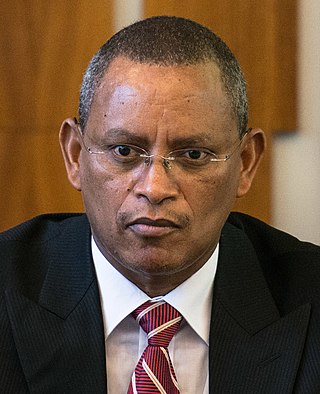
Debretsion Gebremichael is an Ethiopian politician serving as the chairman of Tigray People's Liberation Front (TPLF). He was previously the president of the Tigray Region. His position as titular head of the Tigray Region was disputed by the federal government of Ethiopia who in November 2020 appointed Mulu Nega as the chief executive of the Transitional Government of Tigray, succeeded by Abraham Belay. From July 2021 to March 2023, Debretsion again led the Tigray Region, while Abraham Belay left the transitional government to become Ethiopia's minister of Defence.

Tigrayan nationalism is an ethnic nationalism that advocates the interests of Tigrayan people in Ethiopia. Inspired predominantly by the Tigray People's Liberation Front (TPLF) with its predecessor Tigray Liberation Front (TLF), this type of nationalism holds that Tigrayans are an independent group with unique ancestry, heritage, history and culture outside Ethiopia. As such, they claim Tigray is the source of Ethiopian civilization and utterly a benefactor of state-building without other local ethnic groups. Tigrayan nationalists accuse Amharas of imposing their cultural, economic and political hegemony over Tigrayans.
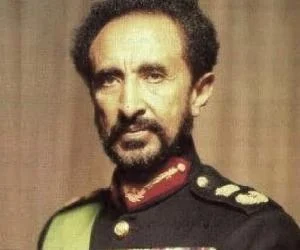
Opposition to Haile Selassie relied largely of internal administration of his country. While Haile Selassie made attempt to modernize the country and brought to global power since Italy's occupation in 1936–41, the later administration met with negative public attitude especially among educated people in universities and peasants.
This is timeline of Mekelle, a city and capital of Tigray Region, Ethiopia.

The Welkait question involves a controversial territorial dispute surrounding the Ethiopian area Welkait, which is situated in the present-day Tigray Region. Welkait had been an independent area but was incorporated within Begmeder province, but after the fall of the Derg in 1991, the area was given by the TPLF government to Tigray's Western Zone. During Abiy Ahmed administration, the Tigray and Welkait Committee counterparts held peaceful talks in Gondar on 19 April 2018. Abiy pleaded the Welkait question should be addressed in peaceful resolution.
















